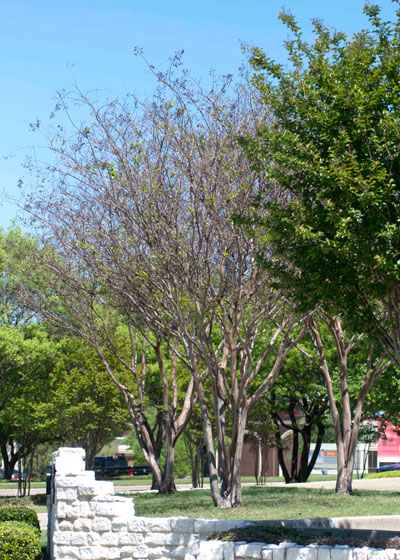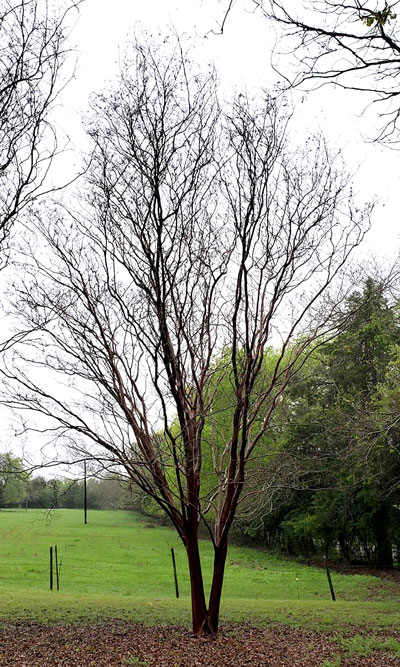Question of the Week – Number 3: April 2, 2020

“My crape myrtles don’t look like they’re going to put out any leaves. Are they dead? What would have caused that?”
If you think back to late October, we had a very early first freeze across much of Texas. And it wasn’t just a glancing blow. It was cold!
Crape myrtles are sub-tropical plants by their nature, and that means that they don’t go dormant in fall in a graceful manner. When the first freeze blasts in like that one did last October, it catches crape myrtles off guard. That’s what happened to these plants.
Unfortunately, we’ve seen this more than once. Those of us with the Crape Myrtle Trails of McKinney have discovered that five varieties, four of them very common, are highly prone to freeze dieback. My wife and I met our son in the parking lot of a grocery three hours ago. He had gotten milk for us. In driving through McKinney I saw that the same five varieties have been frozen again. They are Natchez, Muskogee, Tuscarora and Sioux, all from the USDA breeding program, and an old variety called Country Red. I’ve even seen the normally very dependable Catawba with freeze damage in our neighbor’s yard this spring.
Another example from a Facebook friend…
Alan B. from rural Grayson County (Sherman area near the Red River) posted this photo of his Natchez on my Facebook page just a few days ago. I have a couple of Natchez, too, and they’ve done this other years.

What I’d tell Alan and anyone else with this kind of dieback…
• The plant isn’t dead, but the top growth apparently is. It froze in that late October early hard freeze. However, the root system will still be alive, and you will soon be seeing new shoots pop up around the base of the old trunks.
• Those new shoots will be your clue that you have lost the top growth. As soon as you see them, cut the old trunks off as close to the ground as you can. Waiting even a couple of weeks will make that all the more difficult as the new shoots quickly grow taller.
• You will probably get 25 or 30 new shoots sprouting up. Leave all of them for a couple of months. Yes, it will look really odd to see a shrubby mass where you had a tree just last fall, but you need to let them grow in size so that you can determine which are the straightest and strongest.
• By late spring or early summer you’ll be able to thin them out so that only eight or nine remain. Let them grow the rest of the summer, then thin them down to five or six this fall. You leave extras because they are quite brittle and easily snapped by a mower, pet or errant football or Frisbee.
• Next spring, once they have become somewhat woody, they are likely to be 6 or 7 feet tall. At that point you can thin them down to the final number of three or five (odd numbers look best). If you’re concerned that they’re still brittle and could be snapped in a windstorm, put 2×2-inch stakes alongside them for a few months.
• Will this all happen to your plant again? Yes, it could if another really bad cold snap plows through. But in the meantime you’ll be pleased with how quickly your plant recovers and looks great again.
Note: This is the very same procedure we recommend for crape myrtles that have been topped in the past, when gardeners want to restore them to their natural growth forms.
